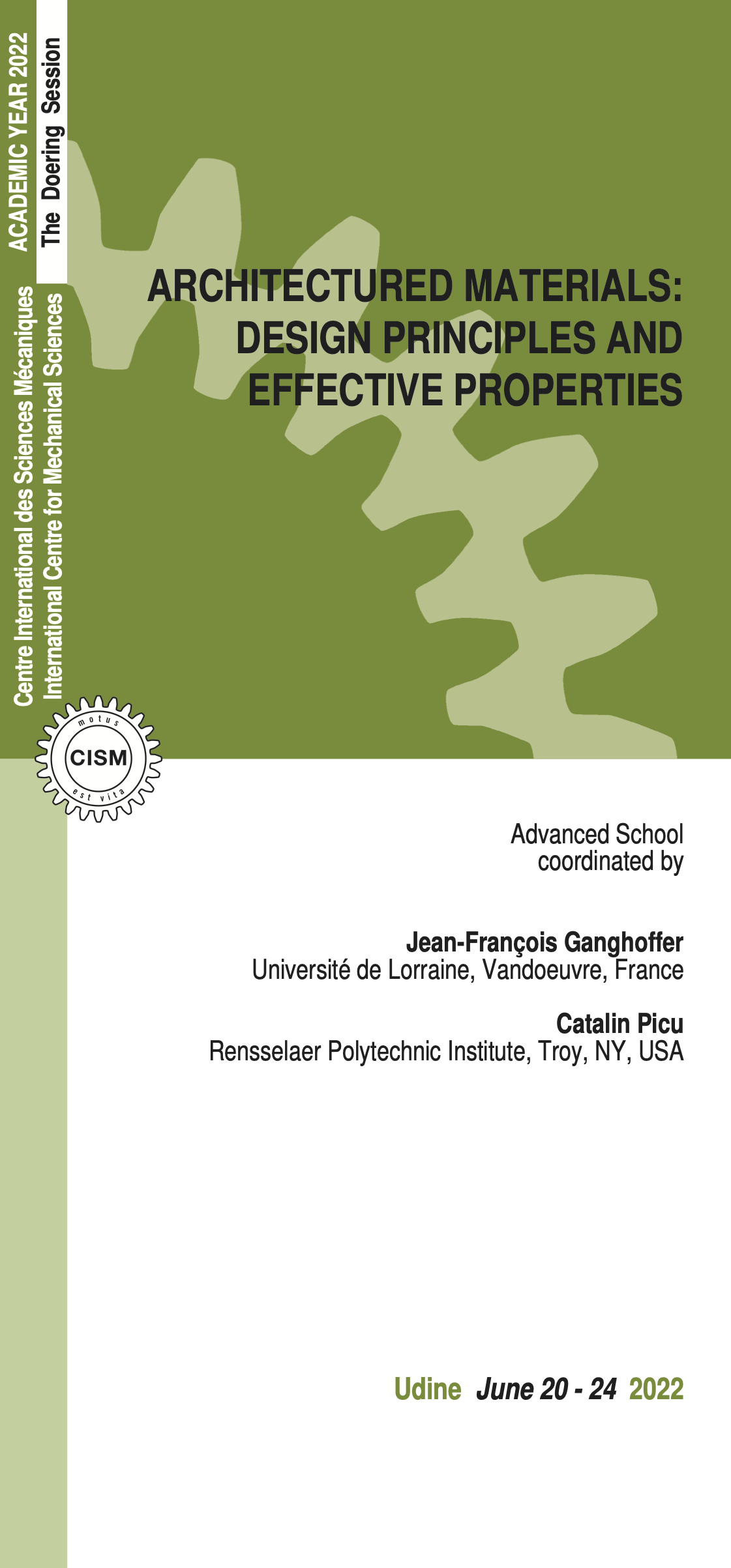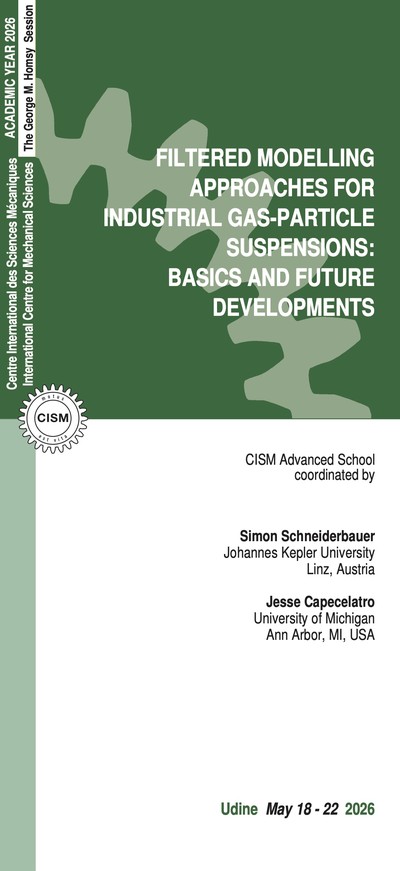Architectured materials are defined at the threshold between structures made from discrete elements and continua. In these materials, topological interactions of the building blocks are essential. The material is composed from phases or objects of dissimilar properties, which are assembled into a structure designed to achieve pre-defined properties, such as improved toughness, increased ductility, or specific wave properties, such as cloaking.
A sub-class of architectured materials is formed by mechanical metamaterials. The term metamaterials is used to denote materials or structures with special dynamic properties. This term currently indicates materials with pre-designed multiscale architecture, which exhibit unusual static and dynamic properties associated with large local deformations, presence of multiple metastable states and instabilities. The microstructure of these materials is predominantly of lattice type, i.e. it is made from beams. Metamaterials derive their properties not from those of the base material, but rather from the architecture of their microstructure. The density, shape, size and spatial arrangement of the constituent components are responsible for the enhanced behavior observed at the macroscale.
Other examples of architectured materials are topologically interlocked materials made from independent blocks that interact at contact points and are assembled such to hold together, and materials with hard and soft periodic domains, as in nacre and bone. These materials have properties that cannot be achieved with conventional continuum composites. Nacre and bone have toughness much larger than that of the predominant hydroxyapatite phase due to the presence of small amounts of soft material (collagen). Topologically interlocked materials are flexible and exhibit toughness larger than that of the material of the constituent blocks because interfaces act as traps for cracks.
A special class of architectured materials have stochastic microstructure. Stochasticity reduces the sensitivity to flaws and reduces the constraints imposed on the process of fabrication. Topologically interlocked materials with stochastic structure are similar to a puzzle of locked objects and their properties are in-between those of a microcracked continuum and of granular material. If the building blocks have large aspect ratio, the ensemble becomes a random fiber network, whose properties are determined by the connectivity and topological interactions between fibers. Many biological and engineering materials are network materials: connective tissue, the extracellular matrix, elastomers, nonwovens, etc.
This course will outline the concepts underlining the function and design of architectured materials and will overview the methods and tools required for the design and material performance evaluation.
A broad range of examples will be discussed, including metamaterials, topologically interlocked, fibrous and highly heterogeneous continua.
The course is addressed to graduate students and postdoctoral researchers in mechanics and materials, and to established researchers interested in the emerging field of architectured materials.
H. Reda, N. Karathanasopoulos, K. ElNady, J.F. Ganghoffer, H. Lakiss, 2018. The role of anisotropy on the static and wave propagation characteristics of two-dimensional architectured materials under finite strains. Materials & design, 147.
S.E. Alavi, J.F. Ganghoffer, H. Reda, M. Sadighi. Construction of micromorphic continua by homogenization based on variational principles. J. Mech. Phys. Solids. 2021. In print.
N. Mawassi, H. Reda, J.F. Ganghoffer, V. Eremeyev, H. Lakiss. A variational approach of homogenization of piezoelectric composites towards piezoelectric and flexoelectric effective media. 2021. Int. J. Engng Sci., 158:103410. DOI: 10.1016/j. ijengsci.2020.103410.
R.C. Picu, “Mechanics of random fiber networks – a review,” Soft Matter, Vol. 7, p. 67686785, 2011.
R.C. Picu, "Mechanics of random fiber networks: structure properties relation" in R.C. Picu and J.F. Ganghoffer (Eds.) Mechanics of fibrous materials and applications. Springer, CISM 596, 2020.
Architectured materials in engineering and biology: fabrication, structure, mechanics and performance F. Barthelat. International Materials Reviews 60(8), p 413-430, 2015.
Simultaneous improvements of strength and toughness in topologically interlocked ceramics M.Mirkhalaf, Tao Zhou, F. Barthelat. Proc. Nat. Acad. Sciences 115(37), 9128-9133 2018.
Y.Estrin, Y. Bréchet, J. Dunlop, P. Fratzl, Architectured Materials in Nature and Engineering, Springer, 2019.
NHP. Nguyen, D. Klotsa, M. Engel, S.C. Glotzer, Emergent collective phenomena in a mixture of hard shapes through active rotation, Phys. Rev. Lett. 112, 075701, 2014.
ER. Chen, D. Klotsa, M. Engel, PF. Damasceno, SC Glotzer, Complexity in surfaces of densest packings for families of polyhedra, Phys. Rev. X 4, 011024, 2014.
6 lectures on: Segmented materials in nature and engineering. Segmented vs. continuous materials: architectures and properties; the very hard with the very soft: interplay between hard elements and soft matrices; weak, soft and deformable interfaces; examples of segmented natural materials: nacre, fish scales, fish fins; order vs. disorder in segmented materials.
6 lectures on: Introduction to architectured materials.
Design and manufacturing of architectured materials; computational mechanics for architectured materials; instabilities in architectured materials; RVE size of stochastic architectured materials.
6 lectures on: Static and dynamical behavior of architected and fibrous materials considering size effects - Applications in biomechanics. Micromechanical models of generalized continua for architected materials and metamaterials: chiral Cosserat mechanics, second gradient, microstretch, micromorphic effective media; discrete and continuous large strain homogenization methods for architected materials; Introduction to multiscale topology optimization methods – Study case: optimal auxetics; plastic, collapse properties of network materials and size effects; Measurement of higher order properties of architectured materials; size effects for hierarchical structures like tendons and bone; multiscale statistical models of tendons.
6 lectures on: Mechanical metamaterials: design, effective proper- ties and applications.
Design and computation of effective properties in the static limit; bloch waves and effective properties; chiral mechanical metamaterials, their effective description by micropolar and Willis elasticity; non-linear mechanical metamaterials for energy absorption; wave control and absorption using transformational elastodynamics.
6 lectures on: Network materials and stochastic fragmented continua.
Mechanical behavior of network materials: small and large strains, damage accumulation and rupture; role of architecture in network materials: exceptional properties emerging from stochasticity and topology; structure-properties relations; biological and engineering applications; stochastic fragmented continua.
6 lectures on: Multiphysical behavior of architected materials.
Piezoelectric and flexoelectric response of architected materials; homogenization methods for piezoelectric and flexoelectric materials; large strains homogenization methods for soft architected materials; identification of anisotropic large strains constitutive models of architected materials; enriched models of random fibrous networks (Cosserat, micromorphic); vibration and wave propagation aspects in architected materials.





